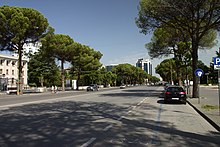Dëshmorët e Kombit Boulevard
 View of the Boulevard looking northward. | |
| Native name | Martyrs of the Nation Boulevard (English) Error {{native name checker}}: parameter value is malformed (help) |
|---|---|
| Type | Public Boulevard |
| Length | 1 km |
| Location | Tirana |
| From | Skanderbeg Square |
| To | Mother Teresa Square |
| Construction | |
| Construction start | 1939 |
| Completion | 1941 |
The Dëshmorët e Kombit Boulevard (English: Martyrs of the Nation Boulevard) is a major boulevard in Tirana, Albania. It was planned by the Italian architect Gherardo Bosio and built in 1939 to 1941, during the Italian occupation of Albania.
When first constructed, it was named the Viale del Impero (Avenue of the Empire).[1] In 1934 to 1935, a bridge was built over the boulevard by Gjovalin Gjadri.[2] During the communist era in Albania, major parades took regularly place including on Liberation Day and International Workers Day.
Many buildings are located along this boulevard, including the Presidential Palace, the Prime Minister's Office, the Palace of Congress, the Rogner Hotel and the University of Tirana. The boulevard enters the city centre from the south and intersects with Bajram Curri Boulevard near the Rinia Park. It then becomes part of Skanderbeg Square and continues north of the centre to Zogu I Boulevard.
The boulevard was immortalised by Edi Hila in a series of paintings titled Martyrs of the Nation Boulevard.[3]
Gallery
-
The view from the Pyramide
-
Old picture of Tirana's car-free main boulevard
-
View from the south end of Mother Teresa Square
-
The Prime Minister's Office building
References
- ^ The Albanians: A Modern History, p.114
- ^ En Structurae
- ^ "Edi Hila: Painter of Transformation - Announcements - e-flux". www.e-flux.com. Retrieved 2018-06-11.




